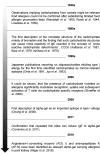The History of Carbohydrates in Type I Allergy
- PMID: 33163001
- PMCID: PMC7583601
- DOI: 10.3389/fimmu.2020.586924
The History of Carbohydrates in Type I Allergy
Abstract
Although first described decades ago, the relevance of carbohydrate specific antibodies as mediators of type I allergy had not been recognized until recently. Previously, allergen specific IgE antibodies binding to carbohydrate epitopes were considered to demonstrate a clinically irrelevant cross-reactivity. However, this changed following the discovery of type I allergies specifically mediated by oligosaccharide structures. Especially the emerging understanding of red meat allergy characterized by IgE directed to the oligosaccharide alpha-gal showed that carbohydrate-mediated reactions can result in life threatening systemic anaphylaxis which in contrast to former assumptions proves a high clinical relevance of some carbohydrate allergens. Within the scope of this review article, we illustrate the historical development of carbohydrate-allergen-research, reaching from only diagnostically relevant crossreactive-carbohydrate-determinants to clinically important antigens mediating type I allergy. Focusing on clinical and immunological features of the alpha-gal syndrome, we highlight the discovery of oligosaccharides as potentially highly immunogenic antigens and mediators of type I allergy, report what is known about the route of sensitization and the immunological mechanisms involved in sensitization and elicitation phase of allergic responses as well as currently available diagnostic and therapeutic tools. Finally, we briefly report on carbohydrates being involved in type I allergies different from alpha-gal.
Keywords: IgE; allergen; alpha-gal; carbohydrate; crossreactive carbohydrate determinants; glycolipid; glycoprotein; type I allergy.
Copyright © 2020 Hils, Wölbing, Hilger, Fischer, Hoffard and Biedermann.
Figures




References
-
- Platts-Mills TAE, Commins SP, Biedermann T, Van Hage M, Levin M, Beck LA, et al. . On the cause and consequences of IgE to galactose-alpha-1,3-galactose: a report from the National Institute of allergy and infectious diseases workshop on understanding IgE-mediated mammalian meat allergy. J Allergy Clin Immunol. (2020) 145:1061–71. 10.1016/j.jaci.2020.01.047 - DOI - PMC - PubMed
Publication types
MeSH terms
Substances
LinkOut - more resources
Full Text Sources
Medical

